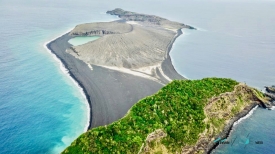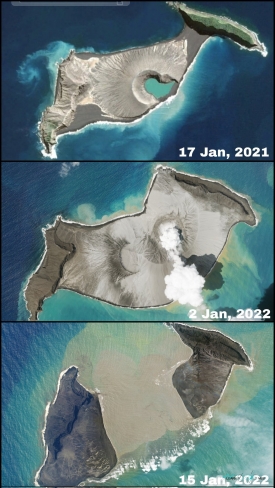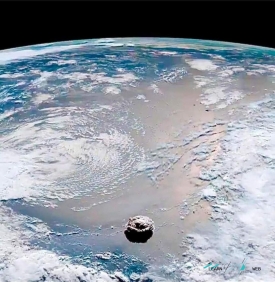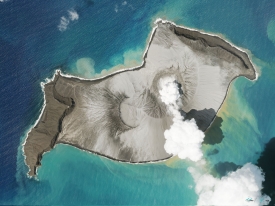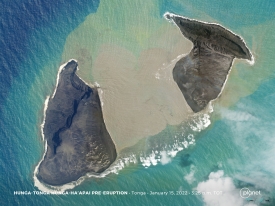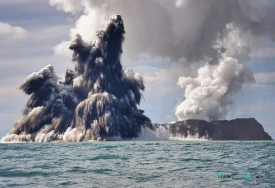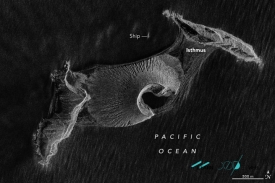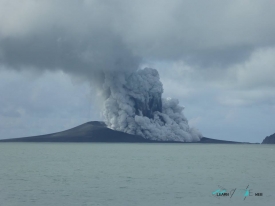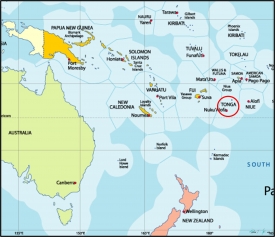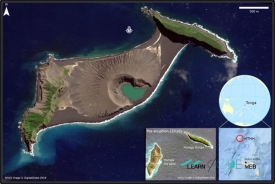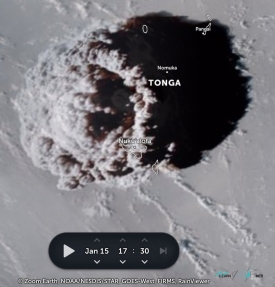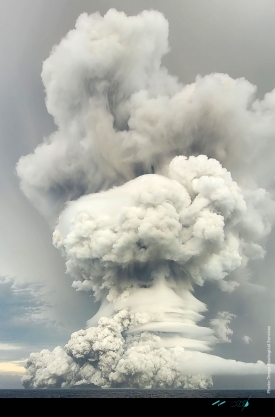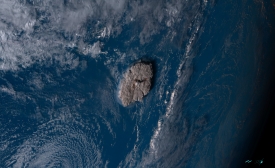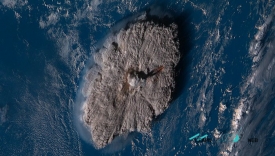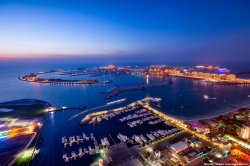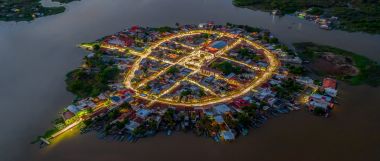ABOUT Hunga Tonga-Hunga Ha´apai
Hunga Tonga–Hunga Haʻapai was an uninhabited volcanic island that existed in the South Pacific from 2009 to 2022, located about 30 km (19 mi) south of the submarine volcano of Fonuafoʻou and 65 km (40 mi) north of Tongatapu, Tonga's main island. The previously twin islands of Hunga Tonga and Hunga Haʻapai were merged by a volcanic eruption in 2009, and a more explosive eruption separated the islands again and reduced them in size in 2022. The erupting volcano is part of the highly active Tonga–Kermadec Islands volcanic arc, a subduction zone extending from New Zealand north-northeast to Fiji. It lies about 100 km (62 mi) above a very active seismic zone. The island arc is formed at the convergent boundary where the Pacific Plate subducts under the Indo-Australian Plate.
The volcano itself is a submarine volcano that breached sea level in 2009 due to a volcanic eruption and lies underwater between two islands, Hunga Tonga and Hunga Haʻapai, which are respectively the remnants of the western and northern rim of the volcano's caldera. The caldera is roughly 150 m below sea-level, and rises 2000 m from the sea-floor. The two islands (part of the Haʻapai group) are about 1.6 km (0.99 mi) apart, and each is about 2 km (1.2 mi) long and composed largely of andesite. This andesite tends to be of the basaltic type. Hunga Tonga reaches an elevation of 149 m (489 ft), while Hunga Haʻapai comes to only 128 m (420 ft) above sea level. Neither island is large: Hunga Tonga was roughly 390,000 m2 (0.15 sq mi) and Hunga Haʻapai 650,000 m2 (0.25 sq mi) in size before they were connected. They are much smaller after the 2022 eruption. Neither island was developed due to a lack of an acceptable anchorage, although there were large guano deposits on each island.
Volcanic activity died down on 5 January before restarting on 13 January after the volcano sent an ash cloud 17 km (55,000 ft) into the atmosphere.[48] The government subsequently issued a tsunami warning. On 15 January, the volcano violently erupted again, about seven times more powerfully than the eruption on 20 December 2021. There were numerous reports of loud booms across Tonga and other countries, such as Fiji and as far away as New Zealand and Australia. A boom was heard in Alaska seven hours after eruption. Near the eruption, the explosion damaged property, including shattered windows. A tsunami warning was issued just after 5:30 p.m. by the Tonga Meteorological Services and the tsunami flooded coastal areas in Tonga. A 3.9 ft (1.2 m) tsunami was observed in Nukuʻalofa, Tonga and a 2.0 ft (0.61 m) one in American Samoa.
Two people were killed in Peru and two fishermen were injured in San Gregorio, California.
It was reported on 16 January that radar surveys before and after the eruption show that most of the island has been destroyed. Only small parts of Hunga Tonga and Hunga Haʻapai remained.
The volcano itself is a submarine volcano that breached sea level in 2009 due to a volcanic eruption and lies underwater between two islands, Hunga Tonga and Hunga Haʻapai, which are respectively the remnants of the western and northern rim of the volcano's caldera. The caldera is roughly 150 m below sea-level, and rises 2000 m from the sea-floor. The two islands (part of the Haʻapai group) are about 1.6 km (0.99 mi) apart, and each is about 2 km (1.2 mi) long and composed largely of andesite. This andesite tends to be of the basaltic type. Hunga Tonga reaches an elevation of 149 m (489 ft), while Hunga Haʻapai comes to only 128 m (420 ft) above sea level. Neither island is large: Hunga Tonga was roughly 390,000 m2 (0.15 sq mi) and Hunga Haʻapai 650,000 m2 (0.25 sq mi) in size before they were connected. They are much smaller after the 2022 eruption. Neither island was developed due to a lack of an acceptable anchorage, although there were large guano deposits on each island.
Volcanic activity died down on 5 January before restarting on 13 January after the volcano sent an ash cloud 17 km (55,000 ft) into the atmosphere.[48] The government subsequently issued a tsunami warning. On 15 January, the volcano violently erupted again, about seven times more powerfully than the eruption on 20 December 2021. There were numerous reports of loud booms across Tonga and other countries, such as Fiji and as far away as New Zealand and Australia. A boom was heard in Alaska seven hours after eruption. Near the eruption, the explosion damaged property, including shattered windows. A tsunami warning was issued just after 5:30 p.m. by the Tonga Meteorological Services and the tsunami flooded coastal areas in Tonga. A 3.9 ft (1.2 m) tsunami was observed in Nukuʻalofa, Tonga and a 2.0 ft (0.61 m) one in American Samoa.
Two people were killed in Peru and two fishermen were injured in San Gregorio, California.
It was reported on 16 January that radar surveys before and after the eruption show that most of the island has been destroyed. Only small parts of Hunga Tonga and Hunga Haʻapai remained.



